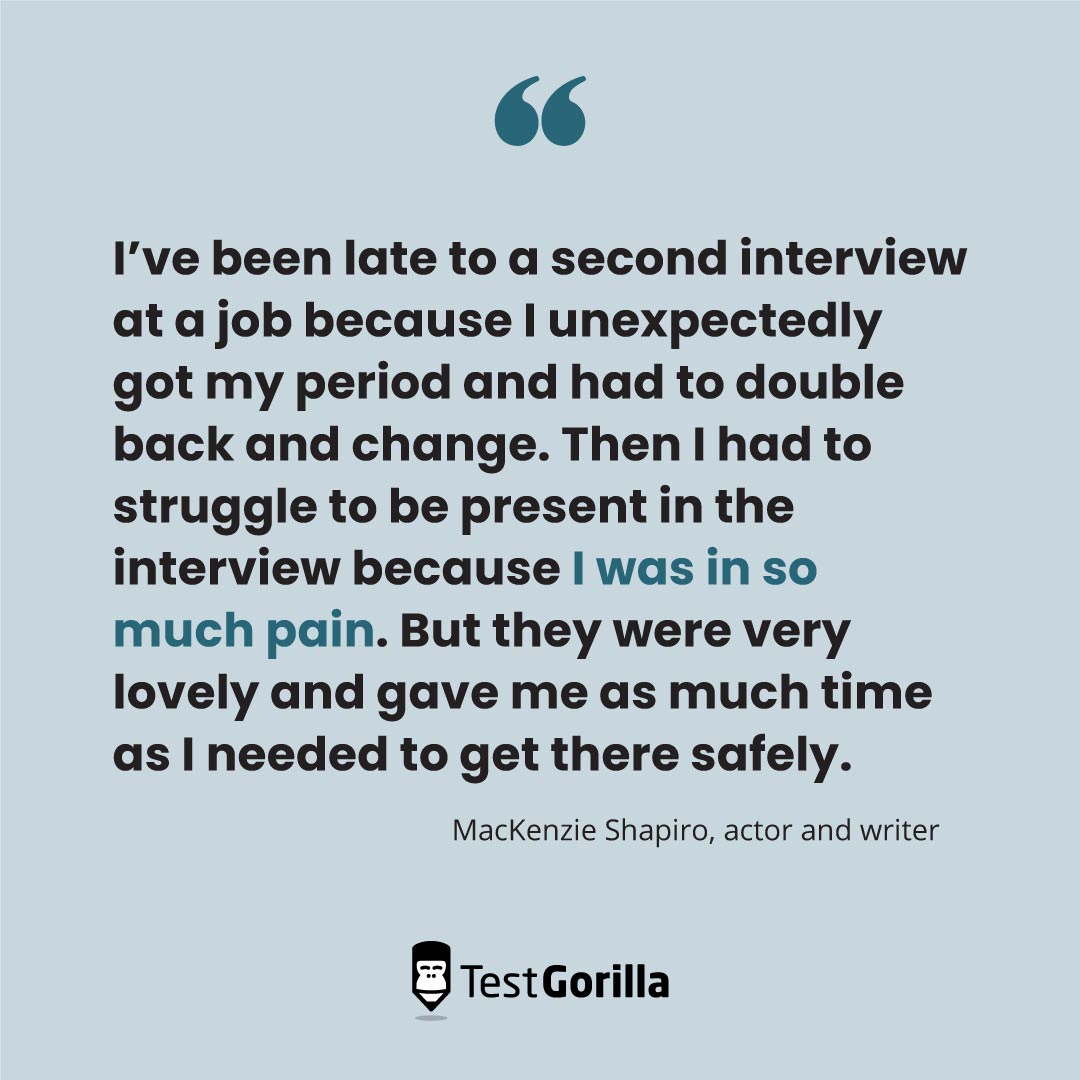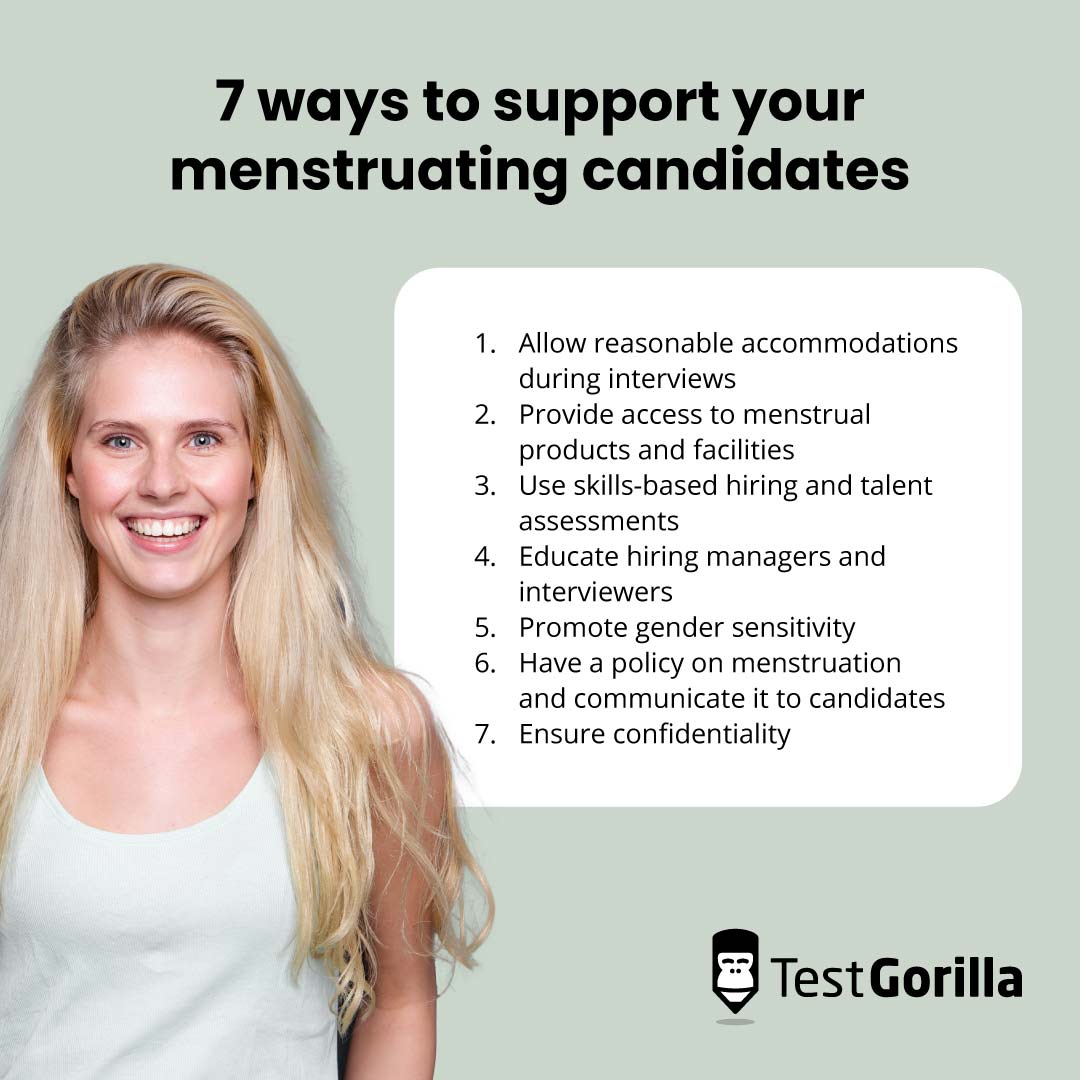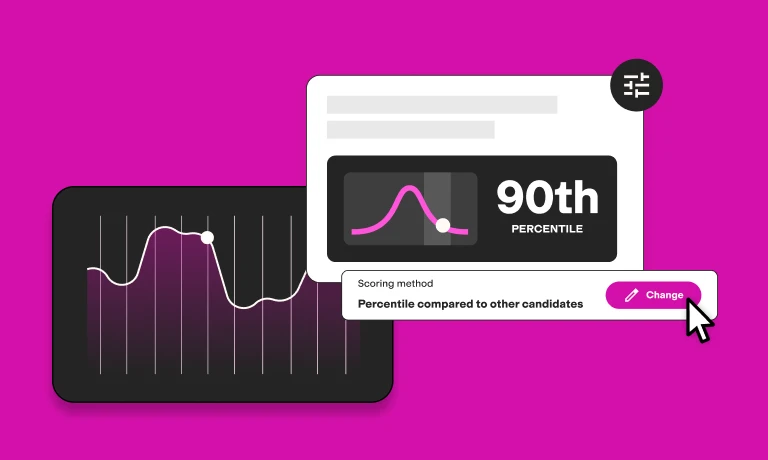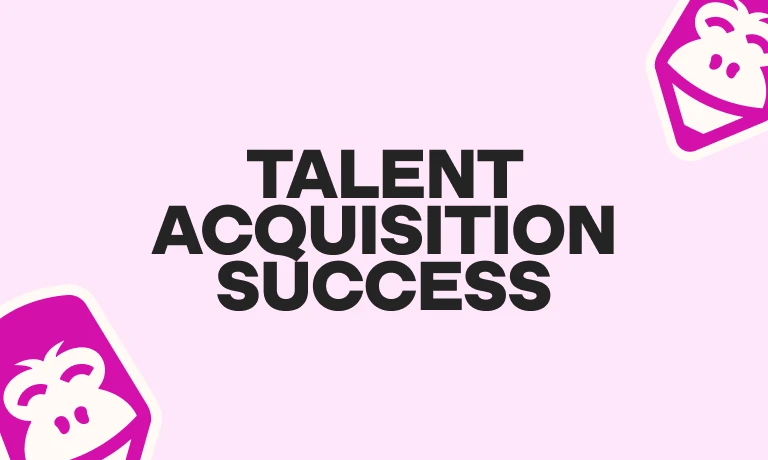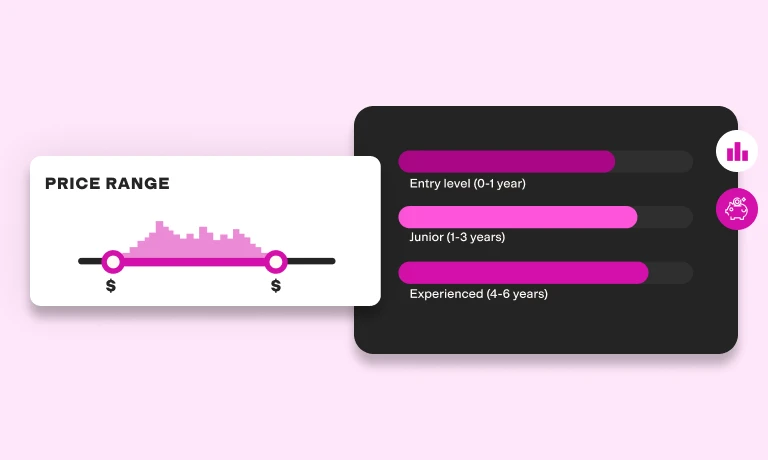Every month, approximately 1.8 billion people around the world menstruate.[1] However, discussing periods at work remains a taboo subject. This means candidates who have to attend job interviews or participate in work trials while they’re on their periods are left with a difficult choice: either pretend to be sick and risk losing an opportunity, or push through, unable to perform at their best.
For companies, this could mean missing out on talented individuals with the potential to transform your business. By creating a menstrual-friendly hiring funnel, you can improve your candidate experience, build stronger teams, and demonstrate your commitment to gender equality.
In this article, we’ll recommend some good practices and alternative recruitment methods to support your menstruating candidates — for example, being open to rescheduling interviews and using skills-based hiring to let candidates take talent assessments when they’re in top shape.
That time of the month
For many individuals, attending interviews or work trials during their period is uncomfortable at best and impossible at worst. Mental and physical symptoms like anxiety, fatigue, headaches, heavy bleeding, and nausea make it harder to leave a good impression or even get out of the house.
A Deloitte survey of 5,000 women found that among the individuals who experience health challenges related to menstruation, 40% report working through the pain at least in part due to the stigma around this topic.[2]
Another study reported that a third of respondents (33%) felt it was unprofessional to mention their menstrual health to their employer.[3] Without feeling safe enough to ask for support at work, these individuals are left at an unfair disadvantage.
We’ve spoken to people worldwide about their experiences with menstruation in a professional setting. One source, an architect in Quebec, spoke about her debilitating symptoms and judgment from colleagues.
I get brain fog and I can’t even find words in my native language… I forget names, can’t do math, get dizzy, and sometimes I make stupid mistakes. Most people think it’s because [I have] poor language or communication skills. I feel like they judge my strength. They feel I’m faking it and making excuses to get out of work. But my period is heavy and my premenstrual syndrome (PMS) side effects limit my skills to a great extent.
Anonymous
There are steps companies and hiring managers can take to make these conditions more manageable for their candidates. In one source’s experience, simply being more understanding goes a long way.
I’ve been late to a second interview at a job because I unexpectedly got my period and had to double back and change. Then I had to struggle to be present in the interview because I was in so much pain. But they were very lovely and gave me as much time as I needed to get there safely.
MacKenzie Shapiro, actor and writer
Let’s take a look at some things you can do to support your menstruating candidates and make your company a more inclusive and equitable place to work.
7 ways to support your menstruating candidates
While we’re still far from breaking the taboo surrounding menstruation, significant strides have been made. For example, Spain introduced a menstrual leave policy in 2022, bringing it in line with other countries like Zambia and South Korea that have implemented similar laws.
Spain’s new policy allows people who suffer from painful periods to take three days off from work, with the possibility to extend it to five days. All they need is a doctor’s note, and the public social security system will cover the cost of the leave.
Here are seven steps you can take as a people-centric organization to be a part of that change:
1. Allow reasonable accommodations during interviews
Offering certain accommodations at the hiring stage levels the playing field for all candidates. It ensures you’re seeing a true reflection of each person’s skills and putting the right people in the right roles.
To improve your candidate experience, allow for:
Flexible scheduling. Let candidates schedule interviews at times that align with their cycles. This flexibility shows understanding and allows them to manage any discomfort or challenges more effectively.
Extended breaks. Permit reasonable breaks during the interview or trial to let candidates manage physical discomfort or fatigue more easily. This will contribute to a more effective and fair assessment.
Remote interview options. Unless meeting in person is absolutely necessary, allow individuals to attend the interview remotely. This can help reduce any anxiety related to transportation or physical discomfort.
Relaxed dress codes. Provide clear guidelines for acceptable interview attire, including suggestions for comfortable and professional clothing. This ensures that candidates have a clear understanding of what is expected while still prioritizing their comfort.
Rescheduling. Implement an open and understanding policy that allows candidates to reschedule if they’re experiencing significant discomfort or health issues, namely related to menstruation.
“If your candidate emailed you and said they’re bleeding uncontrollably from their arm, have severe nausea and a high fever, you would let them reschedule in a heartbeat. I don’t see why this should be any different. The symptoms are the same.” – Anonymous source
2. Provide access to menstrual products and facilities
Make sure menstrual products, like pads, tampons, or menstrual cups, are available in all restrooms or designated areas, not just the women’s bathrooms. This lets candidates of all genders manage their menstruation safely and hygienically while they’re at your company. It’s also a good step toward creating a more trans-inclusive workplace.
Self-contained toilets with sinks and specialized disposal bins also make it easier for individuals to manage their periods in a sanitary, comfortable way.
Insufficient access to these products, on the other hand, carries potential health risks. Menstruating individuals might resort to using tampons or other products for longer than recommended, increasing their risk of infections or toxic shock syndrome.
By providing accessible products and hygienic facilities, you can help safeguard the well-being of both your candidates and current employees. This also demonstrates your commitment to gender equity and inclusivity. By taking proactive steps to meet your people’s basic needs, you can empower women and menstruating individuals, acknowledge their unique experiences, and contribute to a more supportive and dignified environment.
Finally, offering these provisions normalizes conversations surrounding menstruation in the workplace. By openly addressing menstrual health and providing necessary resources, you can break the silence and reduce the stigma associated with periods. This encourages a more open and inclusive dialogue, fostering understanding and empathy between colleagues.
3. Use skills-based hiring and talent assessments
Skills-based hiring is a data-backed, objective recruitment methodology that lets you hire candidates based on quantifiable skills, as opposed to subjective criteria like resumes or personal referrals.
This method creates a fairer, more inclusive hiring process that benefits your people and can transform your business. According to our 2022 State of Skills-based Hiring report, 72.1% of candidates hired using skills-based hiring were either happy or very happy in their role, compared to 62.9% of individuals recruited through other methods.
Furthermore, only 3.2% of team members recruited using skills-based hiring plan to leave their roles in the next 12 months, compared with 7.3% of employees who were not recruited via this method. Some other business benefits of skills-based hiring include reduced levels of mis-hires, employee turnover, and cost-to-hire.
Pre-employment testing helps your menstruating candidates by:
Giving them an opportunity to showcase their skills without the additional burden of managing menstrual symptoms or discomfort. That’s because they can choose to take the test when they’re in a better physical and mental state.
Creating a fair and inclusive environment where their menstrual status isn’t a hindrance.
Helping to mitigate any potential bias or discrimination that might influence their chances of success.
4. Educate hiring managers and interviewers
Informed hiring managers play a pivotal role in ensuring the fair treatment of menstruating candidates during the recruitment process. Understanding the potential impact of menstrual symptoms on performance allows you to assess candidates holistically and appreciate their capabilities beyond temporary discomfort.
This way, you can foster a culture of empathy and inclusivity and be a leader in gender equality and employee well-being.
To do this:
Integrate period awareness into diversity and inclusion training programs. This can help dispel myths and misconceptions surrounding this topic. Provide resources like workshops and online classes to give your people the necessary knowledge to make informed decisions and mitigate unconscious bias.
Foster an open dialogue about menstruation within the workplace to help break down barriers. Start by creating an environment where employees feel comfortable discussing their menstrual needs without fear of judgment or retribution. Encouraging conversations, establishing confidential channels for requesting accommodations, and implementing flexible work policies can help.
Invite healthcare professionals, menstrual health advocates, or guest speakers to deliver presentations or participate in panel discussions. These experts can provide in-depth knowledge, answer questions, and address common misconceptions.
Launch internal awareness campaigns to foster empathy and highlight the challenges menstruating individuals face on a regular basis. Use different communication channels like newsletters or social media to share educational content and personal stories.You can also explore using period pain simulators that mimic the sensation of menstrual cramps. These wearable tools give non-menstruators a tangible experience, allowing them to gain a deeper understanding of the physical discomfort associated with menstruation.
For a quick demonstration of a period pain simulator in action, watch the video below:
Save 20% on period relief. Use code: TIKTOK20 #periodtiktok #periodsimulator #endo #periodpain #funnyvideos
5. Promote gender sensitivity
Promoting gender sensitivity means recognizing and validating the experiences of people of all genders, including menstruating individuals. This empowers you to build an inclusive environment that meets everyone’s needs.
Doing that lets you attract and retain top talent and build happier, more resilient teams. To promote gender sensitivity:
Strive for diversity in leadership positions and decision-making roles. Having a diverse range of perspectives at the top lets your organization understand and address the needs of both employees and clients better. Having more women in senior positions also helps you better support your menopausal employees and candidates.
Write inclusive job ads. Avoid using language that can be exclusionary or biased, like a job title that includes gender or other demographic identifiers. For example, instead of ‘salesman,’ use ‘sales representative’ or ‘sales associate.’ Instead of ‘waiter/waitress,’ use ‘waitstaff’ or ‘server.’
Review and revise dress code policies to make sure they’re gender-neutral, and let both candidates and employees express their gender identity without restrictions or biases.
Partner with external organizations or nonprofits focused on gender equality and inclusion to learn best practices, collaborate on initiatives, and share resources.
Provide specialized training for managers and leaders to improve their understanding of gender issues, biases, and inclusive leadership practices. This also equips them to be better advocates for gender equality within their teams.
6. Have a policy on menstruation and communicate it to candidates
Having a menstruation policy formalizes your commitment to diversity and inclusion and sets clear expectations for employees, leaders, and candidates alike. It provides a framework for understanding the rights, accommodations, and support available to those who menstruate.
When you’re recruiting, openly share your company’s policy on menstruation with candidates. You can include it on the company website, job postings, or candidate information packages. This way, you’re proactively letting people know your organization is inclusive and open. As a result, they’ll be more likely to trust you and be open about any difficulties they might be experiencing.
Here are some ideas for what to include in your policy:
Availability of menstrual leave. Specify the number of days or hours of leave available and the process for requesting it.
Possibility for flexible work arrangements during the menstrual cycle, like the option to work remotely, adjust working hours, or take breaks when needed.
Accommodations available to support employees during menstruation. For example, you can provide access to private spaces for managing menstrual hygiene, allow for discreet disposal of products, or offer the option to adjust workstations or seating arrangements.
The company’s zero-tolerance policy for discrimination, harassment, or stigmatization based on menstruation. Clearly state that any form of discrimination or harassment related to menstruation will not be tolerated and will be dealt with accordingly.
The importance of maintaining confidentiality and privacy regarding menstrual issues. Assure candidates that the personal information they choose to share with you is entirely confidential.
7. Ensure confidentiality
Confidentiality is the difference between fostering trust, respect, and psychological safety or creating an environment of apprehension and uncertainty.
Respecting the privacy of employees and candidates creates a safe space where they feel comfortable discussing their needs, seeking support, and accessing necessary accommodations — all without fearing judgment, embarrassment, or discrimination. It also lays the foundation for future open dialogue and change.
Here are some ways to ensure confidentiality:
Implement strict data protection measures to protect any sensitive information your candidates share. This includes secure storage, limited access, password protection, and encryption where necessary.
Limit access to confidential information only to those who genuinely need it to provide support or accommodations. Clearly define those roles and their responsibilities regarding handling sensitive information and provide training if necessary.
Consider having managers and HR professionals who handle sensitive information sign non-disclosure agreements. This document should explicitly address the need for confidentiality when it comes to personal and health-related information, including matters related to menstruation.
Conduct regular audits and monitor access to sensitive information to make sure confidentiality protocols are being followed. This includes reviewing access logs and conducting periodic assessments of your data handling practices.
The best insights on HR and recruitment, delivered to your inbox.
Biweekly updates. No spam. Unsubscribe any time.
Beyond accommodations: Empower your menstruating candidates
The stigma surrounding periods at work puts many menstruating candidates and job seekers on an unequal playing field. For these individuals, mental and physical symptoms like low mood, extreme cramping, and dizziness hold them back from giving it their all during interviews and job trials. For some, it keeps them confined to the house entirely.
If companies don’t take action to ensure equal access and opportunity, they may lose out on the opportunity to build more diverse, high-performing teams. In this piece, we presented seven steps to empower your menstruating candidates, enabling them to showcase their full skills without battling debilitating symptoms.
To do this, allow reasonable accommodations during interviews, create and communicate a comprehensive policy on menstruation at work, and use skills-based hiring to create a fairer, more inclusive hiring process.
Remember, this isn’t about giving [menstruating individuals] an unfair advantage. It just puts everyone at the same starting point.
Anonymous
Successfully implementing these practical steps in your organization can help you demonstrate your commitment to inclusivity, fairness, and supporting the needs of all candidates.
Want to foster a healthier workplace culture and gain a competitive edge? Learn how skills-based hiring gives you a more objective way to hire diverse talent and build high-performing teams. Download the 2022 State of Skills-Based Hiring report.
Sources
“Menstrual hygiene: Gender inequality, cultural taboos and poverty can cause menstrual health needs to go unmet.” UNICEF. Accessed June 2, 2023. https://www.unicef.org/wash/menstrual-hygiene
“Deloitte’s Women @ Work report reveals signs of progress, but much work remains to improve women’s experiences in the workplace.” (2023.) Deloitte. Accessed June 2, 2023. https://www.deloitte.com/global/en/about/press-room/deloittes-women-at-work-report-reveals-signs-of-progress-but-much-work-remains.html
“Bloody Good Research. Periods & Menstrual Wellbeing in the Workplace: The Case for Change.” (2021.) Bloody Good Period. Accessed June 2, 2023. https://www.bloodygoodperiod.com/employers-research
Related posts
You've scrolled this far
Why not try TestGorilla for free, and see what happens when you put skills first.


